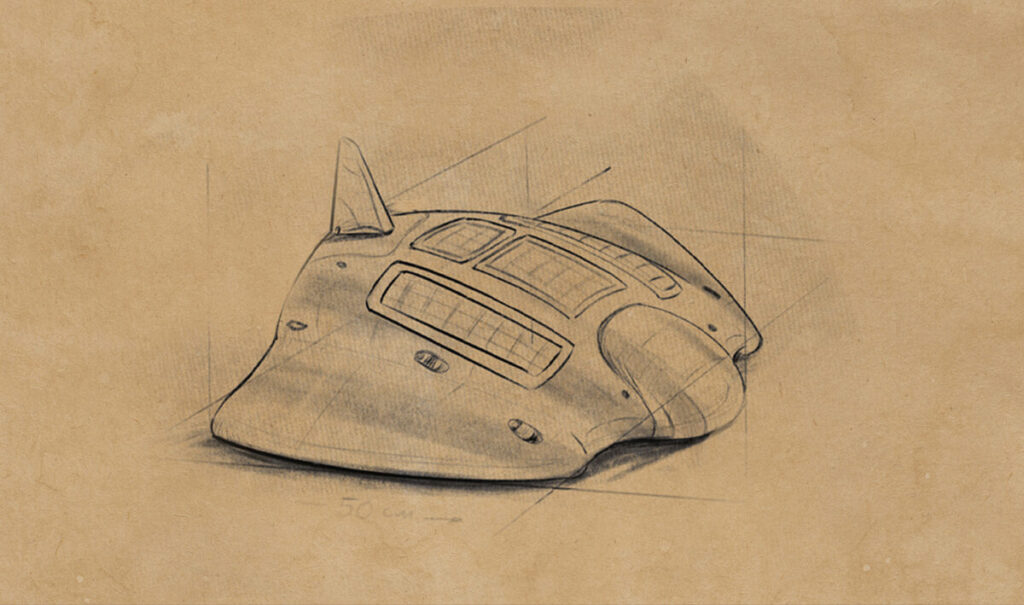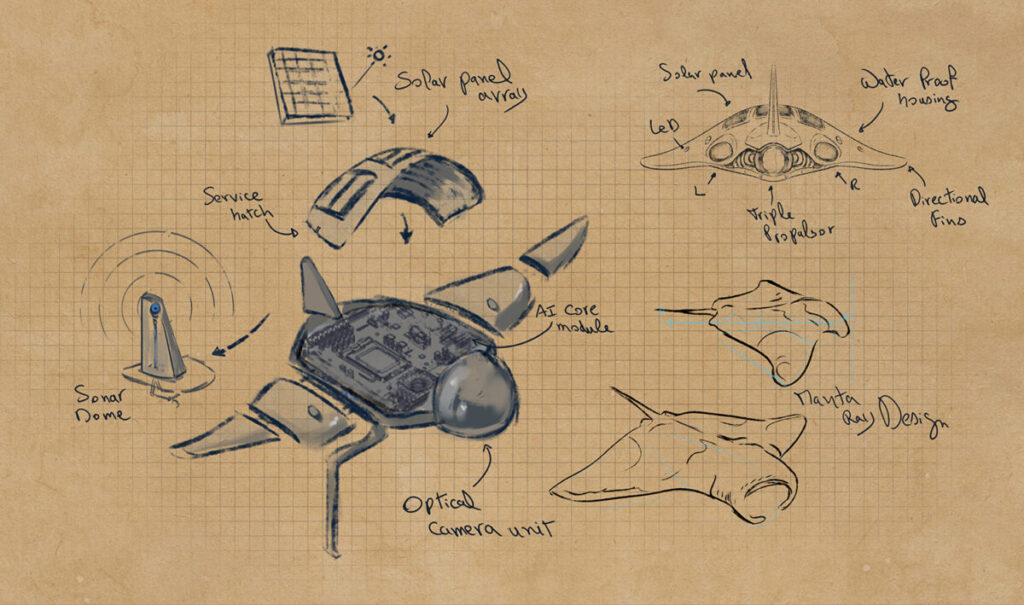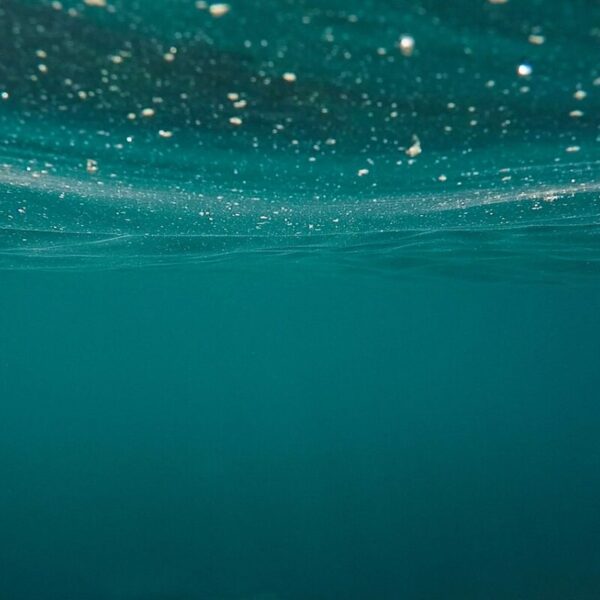A fleet of autonomous drones, capable of spotting, sucking up, and mapping microplastics in the sea: this is the crazy bet of a self-taught inventor from Marseille, supported by a digital entrepreneur. After three years of research, their project is entering the deployment phase, with the first fifty prototypes set to be launched off the coast of Marseille by the end of the year. Equipped with sensors, these miniature and eco-friendly drones filter water day and night, without interruption. They store particles and simultaneously generate an accurate map of marine pollution. The goal: to prove that continuous action can eventually clean up the Mediterranean.
AI Index: Mediterranean Knowledge Library
Underwater drones to clean the Mediterranean of its microplastics
22-med – October 2025
• In Marseille, a self-taught inventor designs marine drones capable of collecting microplastics 24/7.
• Combining artisanal innovation and digital entrepreneurship, the project aims to make the Mediterranean a laboratory for robotic depollution.
#mediterranean #environment #technology #marseille #pollution #innovation #ocean #robotics
By Olivier Martocq - journalist
“I would like, without claiming to clean the oceans, to leave my daughters something pleasant,” confides Jérôme Mercier. Born in Marseille, this sea lover worked for a long time in electronics applied to events before embarking on a rather ambitious adventure: designing marine robots capable of continuously collecting plastic microparticles. “This project was born from a mix of my geek passion and my love for the sea,” he explains. “I wanted to create useful machines, but also poetic ones. These little robots that clean the sea with my daughters represent an unforgettable memory.”
A miniature army at the service of the oceans
The devices he has imagined do not exceed fifty centimeters. Autonomous thanks to solar batteries, they communicate with each other over a distance of about fifteen kilometers, forming a true connected fleet. “Their only mission is to collect microplastics, 24 hours a day,” summarizes Jérôme Mercier. The robots patrol the surface and up to sixty centimeters deep - the area where, according to his observations - “the plastic soup” characteristic of the Mediterranean concentrates.
Equipped with sensors, they filter the water, store particles, and simultaneously generate an accurate map of marine pollution. “They produce what we call heatmaps, thermal maps of contamination. This way, we know where to concentrate our efforts, with latitude and longitude to back it up,” he details. Onboard sensors detect nets, boats, or waves to avoid collisions and losses. And when the small robots reach their maximum capacity, they are emptied by larger vessels, the “conquerors,” true dump trucks of the sea.
The design of these drones also posed an ecological challenge. “I wanted the project's carbon footprint to be almost zero,” emphasizes the inventor. Goodbye fiberglass: the hulls are now made from biodegradable plastic. If a robot were to sink, only the electronics would be lost.

Artificial intelligence as the conductor
To coordinate this fleet, Jérôme Mercier has designed an artificial intelligence system tasked with analyzing the collected data. “The AI digests a monstrous volume of information. It thus determines which areas to prioritize, avoids unfavorable weather conditions, and redirects the robots.” But the interest does not stop at logistics. The AI also has an educational purpose: to translate technical data into readable content for the general public, decision-makers, and researchers. “When a geek speaks, often we understand nothing,” smiles the inventor. “The AI will make this knowledge accessible, making people aware that even clear water can be saturated with microplastics.”
There remains the always very risky transition from prototyping to proof of concept, particularly the financial viability of such a project. This is where Sami Chlagou, a film and video game producer, comes in, heading the company Cross The Ages. “Jérôme touched me with his sincerity and vocation. He didn’t want to sell an idea, but to realize a useful dream,” he recounts. “My role is to give him the means to make it happen on a large scale.” Sami Chlagou is now overseeing the commercialization and fundraising for the project, with a clear ambition: “to make it a global product.” And for that, to break away from traditional financial codes and meanders. The first phase of deployment will take place in Marseille, with fifty robots launched in the next two months.
A planetary ambition
The economic model envisioned by Chlagou aims to be participatory. “The general public will be able to buy their own robot at a very competitive price,” he explains. “The idea is to allow everyone to contribute to depollution, to have their own fleet, even if modest.” The system is inspired by the gaming world, of which he is a major player today. A global ranking will reward the robots or fleets that have collected the most plastic. “Brands, institutions, or even individuals will be able to sponsor robots. We want to create positive emulation, a virtuous competition.” The project has already attracted several potential partners, from environmental foundations to research institutes, as well as large groups drawn to this innovative challenge. “There is an obvious scientific interest,” confirms Chlagou. These robots can provide unprecedented data on the distribution of plastic in the seas.”
But the two men want to go further. “Marseille is a starting point,” asserts Jérôme Mercier. “If we prove it works here, we can replicate the fleet everywhere: in ports, lakes, rivers, and industrial areas.” Between Mercier's artisanal creativity and Chlagou's entrepreneurial rigor, the alliance could well set a precedent.
“It’s the meeting of a geek and a strategist,” summarizes the inventor. “I tinker, he structures.” In two months, the first robots will take to the sea. And if the testing phase proves conclusive, the Mediterranean could well become the global laboratory for robotic depollution. “We are not in science fiction,” insists Sami Chlagou. “We are in a gentle, Marseille-based, and concrete revolution.”
Jérôme Mercier: self-taught inventor

Born in Marseille, a former technician in events, Jérôme Mercier left school in his final year “due to lack of computer science.” Passionate about electronics, he has been designing a fleet of autonomous marine drones capable of collecting and mapping microplastics for three years. A project fueled by his love for the sea and the desire to leave his daughters a slightly cleaner planet.
Sami Chlagou: connected entrepreneur

Film producer and CEO of Cross The Ages, a transmedia universe combining blockchain and video games, Sami Chlagou puts his expertise to work for the international deployment of the fleet of drones. As both an investor and marketing strategist, he oversees the fundraising and commercialization phase, convinced that technology can also repair the sea.

Photo credit: © Pexels - Pixabay
